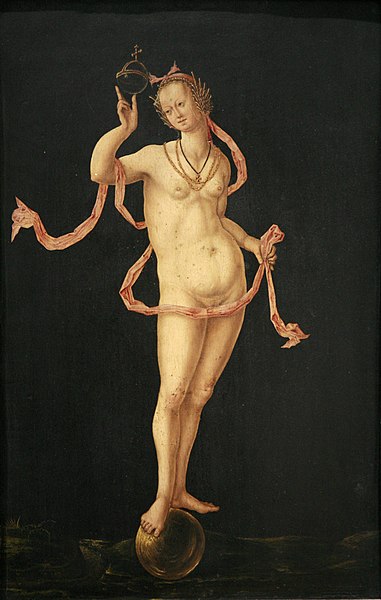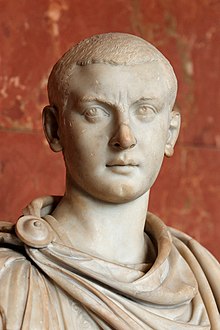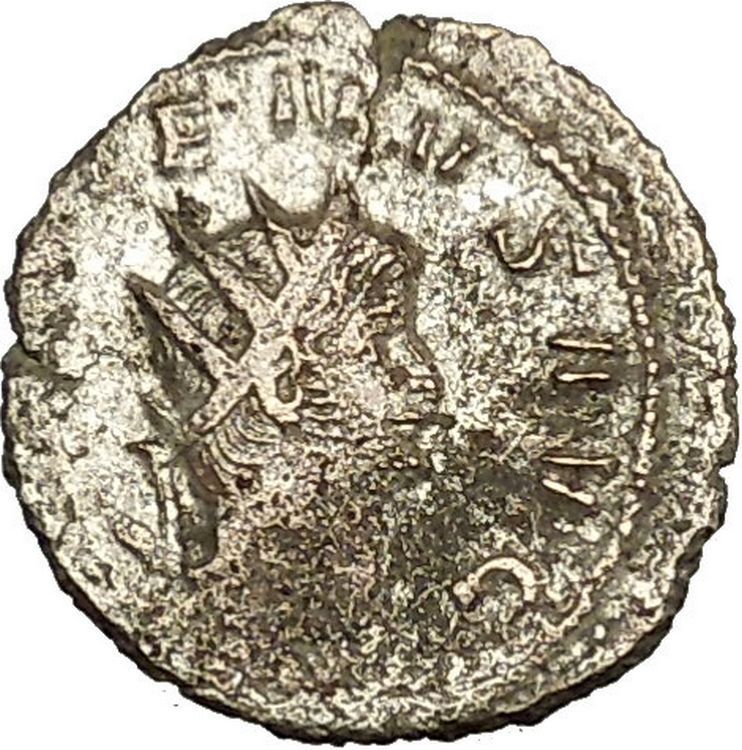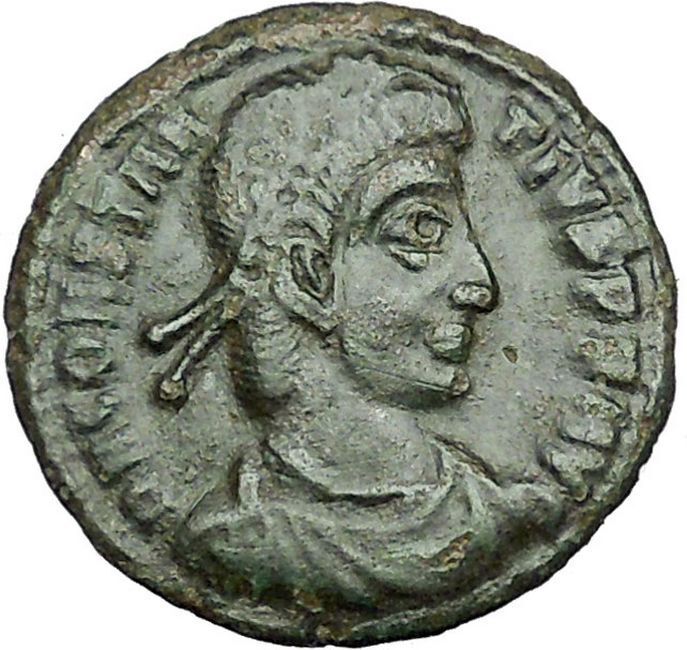|
Gordian III – Roman Emperor: 238-244 A.D.
Silver Antoninianus 24mm (4.37 grams) Antioch mint 243 A.D.
Reference: RIC 210, C 98
IMPGORDIANVSPIVSFELAVG – Radiate, draped and cuirassed bust right.
FORTVNAREDVX – Fortuna seated left, holding rudder and cornucopia.
You are bidding on the exact item pictured, provided with a Certificate of Authenticity and Lifetime Guarantee of Authenticity.
Fortuna (Latin: Fortūna, equivalent to the Greek goddess Tyche) was the goddess of fortune and personification of luck in Roman religion. She might bring good luck or bad: she could be represented as veiled and blind, as in modern depictions of Justice, and came to represent life’s capriciousness. She was also a goddess of fate: as Atrox Fortuna, she claimed the young lives of the princeps Augustus‘ grandsons Gaius and Lucius, prospective heirs to the Empire.
Her father was said to be Jupiter and like him, she could also be bountiful . As Annonaria she protected grain supplies. June 11 was sacred to her: on June 24 she was given cult at the festival of Fors Fortuna.
Cult

Fortuna and Pontos
Fortuna’s Roman cult was variously attributed to Servius Tullius – whose exceptional good fortune suggested their sexual intimacy – and to Ancus Marcius. The two earliest temples mentioned in Roman Calendars were outside the city, on the right bank of the Tiber (in Italian Trastevere). The first temple dedicated to Fors was attributed to the Etruscan Servius Tullius, while the second is known to have been built in 293 BC as the fulfilment of a Roman promise made during later Etruscan wars The date of dedication of her temples was 24 June, or Midsummer’s Day, when celebrants from Rome annually floated to the temples downstream from the city. After undisclosed rituals they then rowed back, garlanded and inebriated. Also Fortuna had a temple at the Forum Boarium. Here Fortuna was twinned with the cult of Mater Matuta (the goddesses shared a festival on 11 June), and the paired temples have been revealed in the excavation beside the church of Sant’Omobono: the cults are indeed archaic in date. Fortuna Primigenia of Praeneste was adopted by Romans at the end of 3rd BC in an important cult of Fortuna Publica Populi Romani (the Official Good Luck of the Roman People) on the Quirinalis outside the Porta Collina. No temple at Rome, however, rivalled the magnificence of the Praenestine sanctuary.

Fortuna lightly balances the orb of sovereignty between thumb and finger in a Dutch painting of ca 1530
(Musée des Beaux-Arts de Strasbourg)
Fortuna’s identity as personification of chance events was closely tied to virtus (strength of character). Public officials who lacked virtues invited ill-fortune on themselves and Rome: Sallust uses the infamous Catiline as illustration – “Truly, when in the place of work, idleness, in place of the spirit of measure and equity, caprice and pride invade, fortune is changed just as with morality”.
An oracle at the Temple of Fortuna Primigena in Praeneste used a form of divination in which a small boy picked out one of various futures that were written on oak rods. Cults to Fortuna in her many forms are attested throughout the Roman world. Dedications have been found to Fortuna Dubia (doubtful fortune), Fortuna Brevis (fickle or wayward fortune) and Fortuna Mala (bad fortune).
She is found in a variety of domestic and personal contexts. During the early Empire, an amulet from the House of Menander in Pompeii links her to the Egyptian goddess Isis, as Isis-Fortuna.[11] She is functionally related to the God Bonus Eventus, who is often represented as her counterpart: both appear on amulets and intaglio engraved gems across the Roman world.
Her name seems to derive from Vortumna (she who revolves the year).

Gordian III – Roman Emperor: 238-244 A.D.
Caesar: 238 A.D. (under Balbinus and Pupienus)
Augustus: 238-244 A.D.
| Grandson of Gordian I | Nephew of Gordian II | Adopted Successor of Balbinus and Pupienus | Husband of Tranquillina |
Marcus Antonius Gordianus Pius (January 20, 225 – February 11, 244), known in English as Gordian III, was Roman Emperor from 238 to 244. Gordian was the son of Antonia Gordiana and his father was an unnamed Roman Senator who died before 238. Antonia Gordiana was the daughter of Emperor Gordian I and younger sister of Emperor Gordian II. Very little is known on his early life before becoming Roman Emperor. Gordian had assumed the name of his maternal grandfather in 238.
Following the murder of emperor Alexander Severus in Moguntiacum (modern Mainz), the capital of the Roman province Germania Inferior, Maximinus Thrax was acclaimed emperor, despite strong opposition of the Roman senate and the majority of the population. In response to what was considered in Rome as a rebellion, Gordian’s grandfather and uncle, Gordian I and II, were proclaimed joint emperors in the Africa Province. Their revolt was suppressed within a month by Cappellianus, governor of Numidia and a loyal supporter of Maximinus Thrax. The elder Gordians died, but public opinion cherished their memory as peace loving and literate men, victims of Maximinus’ oppression.
Meanwhile, Maximinus was on the verge of marching on Rome and the Senate elected Pupienus and Balbinus as joint emperors. These senators were not popular men and the population of Rome was still shocked by the elder Gordian’s fate, so that the Senate decided to take the teenager Gordian, rename him Marcus Antonius Gordianus as his grandfather, and raise him to the rank of Caesar and imperial heir. Pupienus and Balbinus defeated Maximinus, mainly due to the defection of several legions, namely the ParthicaII who assassinated Maximinus. But their joint reign was doomed from the start with popular riots, military discontent and even an enormous fire that consumed Rome in June 238. On July 29, Pupienus and Balbinus were killed by the Praetorian guard and Gordian proclaimed sole emperor.
Rule
Due to Gordian’s age, the imperial government was surrendered to the aristocratic families, who controlled the affairs of Rome through the senate. In 240, Sabinianus revolted in the African province, but the situation was dealt quickly. In 241, Gordian was married to Furia Sabinia Tranquillina, daughter of the newly appointed praetorian prefect, Timesitheus. As chief of the Praetorian guard and father in law of the emperor, Timesitheus quickly became the de facto ruler of the Roman empire.
In the 3rd century, the Roman frontiers weakened against the Germanic tribes across the Rhine and Danube, and the Sassanid kingdom across the Euphrates increased its own attacks. When the Persians under Shapur I invaded Mesopotamia, the young emperor opened the doors of the Temple of Janus for the last time in Roman history, and sent a huge army to the East. The Sassanids were driven back over the Euphrates and defeated in the Battle of Resaena (243). The campaign was a success and Gordian, who had joined the army, was planning an invasion of the enemy’s territory, when his father-in-law died in unclear circumstances. Without Timesitheus, the campaign, and the emperor’s security, were at risk.
Marcus Julius Philippus, also known as Philip the Arab, stepped in at this moment as the new Praetorian Prefect and the campaign proceeded. In the beginning of 244, the Persians counter-attacked. Persian sources claim that a battle was fought (Battle of Misiche) near modern Fallujah (Iraq) and resulted in a major Roman defeat and the death of Gordian III. Roman sources do not mention this battle and suggest that Gordian died far away, upstream of the Euphrates. Although ancient sources often described Philip, who succeeded Gordian as emperor, as having murdered Gordian at Zaitha (Qalat es Salihiyah), the cause of Gordian’s death is unknown.
Gordian’s youth and good nature, along with the deaths of his grandfather and uncle and his own tragic fate at the hands of another usurper, granted him the everlasting esteem of the Romans. Despite the opposition of the new emperor, Gordian was deified by the Senate after his death, in order to appease the population and avoid riots.
|













